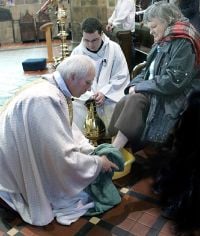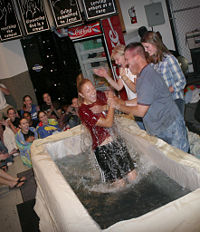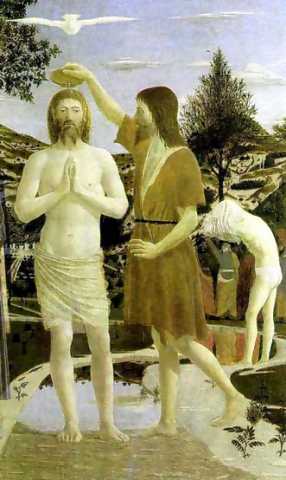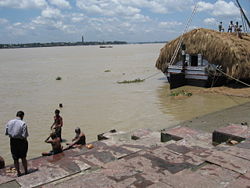Ablution
Ablution is a term referring to washing, and can mean ordinary washing, hand washing, or washing of the body. By extension, ablutions can refer to a collection of regular activities taken to produce physical cleanliness, including washing but also tasks like oral hygiene, and shaving. It is most often a term used to refer to ritual or sacred washing for the purpose of ritual purification in conjunction with prayer within various religious traditions.
Ablutions of one sort or another are practiced in nearly every religious tradition, ranging from hand-washing before eating in the Jewish tradition to baptism in the Christian tradition, ritual washing before prayers in Islam, and bathing in the Ganges River in Hinduism.
Ablution in Judaism
Ablution takes two main forms in Judaism: tevilah, full body immersion in a mikvah (ritual bath) or body of "living water," and netilat yadayim, washing the hands, especially with a cup. The first written records for these practices are found in the Hebrew Bible, and are elaborated in the Mishnah and Talmud. They have been specified in various codes of Jewish law and tradition, such as Maimonides's Mishneh Torah (twelfth century) and Joseph Karo's Shulchan Arukh (sixteenth century). These customs are most commonly observed within Orthodox Judaism. In Conservative Judaism, the practices are normative with certain leniencies and exceptions, and in Reform Judaism, they are not required.
The biblical regulations of Yom Kippur require the officiating High Priest to bathe himself in water after sending off the scapegoat, and a similar requirement was imposed on the person who lead the scapegoat away, and the person who burned the sacrifices during the rituals of the day.[1] The Mishnah states that the High Priest had to immerse himself five times, and his hands and feet had to be washed ten times.[2] In modern Orthodox Judaism, the laity immerse themselves on the day prior to the day of Yom Kippur and often do so before the three pilgrimage festivals, and before Rosh Hashanah; Haredi Jews additionally immerse themselves at least before a Shabbat, and Hasidic Jews do so daily before morning prayers.
Traditional Judaism requires certain other types of ritual washing. Those that do not require complete immersion include:
- Negel vasser ("Nail water"). When getting up in the morning after a full night's sleep, or even after a lengthy nap, there is the custom to wash one's hands ritually by pouring a large cup of water over one's fingers, alternating three times. In the custom of some communities, it is also done after engaging in sexual intercourse or other seminal emission.
- Netilat yadayim ("Raising the hands"). This is done with a blessing prior to eating any bread with a meal, and done without a blessing after touching a ritually impure object, such as one's private parts, leather shoes, an insect or animal, or after paying a visit to a cemetery. During a Passover Seder, an additional netilat yadayim is performed without a blessing before the eating of the vegetable called karpas, prior to the main meal.
- Mayim acharonim ("After-waters"). This is the law or custom of ritually washing off one's fingers after a meal, to protect oneself from touching the eyes with hazardous residue.
- Before blessing of Asher yatzar ("Who created [the man]"). After having either urinated or defecated, the ritual washing of one's hands as a symbol of both bodily cleanliness and of removing human impurityâsee Netilat yadayim above.
- To remove tuma ("impurity") after cutting one's hair or nails.
- To remove tumat meit ("impurity from death") after participating in a funeral procession, or entering a cemetery, or coming wihtin four cubits of a corpse.
- Some communities observe a requirement for washing one's body (which may be done with tap water) after experiencing a seminal emission, including during sexual intercourse, in which case both the man and the woman are affected.
- Each Kohen (priest descended from Aaron) present in synagogue services has his hands ritually washed by the Levites before uttering the priestly blessing in front of the congregation.
Others types of washing require full immersion in special a body of water, such as a spring, stream, or mikva. These include:
- Ablutions by a married Jewish woman following menstruation or other uterine bleeding when she wishes to resume conjugal relations with her husband.
- Bathing the day before Yom Kippur and other Festivals.
- Bathing many Orthodox Jews on Friday afternoons in preparation for the Sabbath.
- A purifying bath when converting to Judaism, the origin of the Christian tradition of baptism.
- Tahara, ("Purification"), the ritual washing and cleansing of a Jew's body prior to burial.
Ablution in Christianity
Christian ablution refers to the practice of removing sins, diseases or earthly defilements through the use of ritual washing, or the practice of using ritual washing as one part of a ceremony to remove sin or disease:
- Baptism. The act of either immersion or sprinkling of water over a new believer, symbolizing his or her rebirth as a member of the Christian church, or mystical body of Christ.
- Blessing. The sprinkling of holy water over a person or congregation, symbolizing the conveying of God's blessing upon them.
- Exorcism. The use of holy water to purify the body of a possessed person and/or drive out the evil spirit which is tormenting him or her.
Many Christian churches also practice a ceremony of the Washing of Feet, following the example of Jesus in the Gospel of John.[3] Some interpret this as an ordinance which the church is obliged to keep as a commandment. Others interpret it as an example that all should follow. Most denominations that practice the rite will perform it on Maundy Thursday. Often in these services, the bishop will wash the feet of the clergy, and in monasteries the Abbot will wash the feet of the brethren.
St. Benedict of Nursia lays out in his Rule that the feet of visitors to the monastery should be washed, and also that those who are assigned to serve in the kitchen that week should wash the feet of all the brethren. [4]
In Roman Catholic and Anglo-Catholic Mass, the priest performs and ablution when he rinses his hands in wine and water following the act of Communion. Another ablution is the practice of lavabo, in which the celebrant washes his/her hands with holy water. In the Eastern Orthodox and Greek-Catholic Churches, the term "ablution" refers to consuming the remainder of the Gifts (the Body and Blood of Christ eaten during the Eucharist service) at the end of the Divine Liturgy.
In the New Testament
Jesus participated in an ablution when he was baptized by John the Baptist to begin his public ministry, and as a Jew he would likely have performed other ablutions as well. Both John's and Jesus' disciples are reported to have baptized many Jews for the remission of sins in preparation for the coming Kingdom of God.
Jesus chastised certain Pharisees for their hypocrisy regarding the practice of ablution (Matthew 23:25), while Jesus' own tradition regarding handwashing was criticized as not strict enough (Matthew 15:2). On the other hand, Jesus instructed his disciples: "When you fast, put oil on your head and wash your face." (Matthew 6:17)
At least one of Jesus' miracles involved him instructing a man to perform an ablution, only after which the miracle became effective: "He spit on the ground, made some mud with the saliva, and put it on the man's eyes. 'Go,' he told him, 'wash in the Pool of Siloam.' So the man went and washed, and came home seeing." (John 9:6-7)
According to the Gospel of Matthew, Pontius Pilate declared himself innocent of the blood of Jesus by by performing a ritual hand washing.[5]
In the Book of Acts, Paul and other men performed ablutions before entering the Temple in Jerusalem: "Then Paul took the men, and the next day purifying himself with them entered into the temple, to signify the accomplishment of the days of purification, until that an offering should be offered for every one of them." [6]
The Epistle to the Hebrews introduces the concept of a spiritual ablution in the sprinkling of Jesus' blood, as a counterpart to the washing of the body through baptism: "Since we have confidence to enter the Most Holy Place by the blood of Jesus... let us draw near to God with a sincere heart ⦠having our hearts sprinkled to cleanse us from a guilty conscience and having our bodies washed with pure water." (Hebrews 10:19-22) Similarly, the Book of Revelation {7:15} also refers to an ablution by the saints in Jesus' blood: "These are they who have come out of the great tribulation; they have washed their robes and made them white in the blood of the Lamb."
Ablution in Islam
The Islamic act of washing parts of the body using water is called wudu(Arabic: اÙÙضÙØ¡ al-wuá¸Å«', Persian:آبدست Äbdast, Turkish: abdest)or (less often) ghusl. Muslims are required to perform wudu in preparation for ritual prayers and for handling and reading the Qur'an. Wudu is often translated as "partial ablution," as opposed to ghusl, or "full ablution."
There are other acts that are performed during wudu (coming from the sunnah of Muhammad and Sunni Islamic scholars) and the detailed acts of the wudu can be classed into three types: FarÄid al-wudu - seven fard (obligatory) acts. If one of these acts is omitted, it must be returned to and then completed in the successive acts to be performed.
- Making the intention.
- Washing the face.
- Washing the arms.
- Wiping the head (in the manner of anointment).
- Wiping the feet to the ankles.
- Rubbing thoroughly when washing.
- Not interrupting wudu.
Sunan al-wudu - seven sunnah (Optional - practised by Muhammad according to Sunni Hadiths) acts. If one of these acts is omitted, it should be completed.
- Washing the hands.
- Rinsing the mouth.
- Sniffing water - and blowing it out the nose
- Wetting the hands to rub the ears.
- Rubbing the ears.
- Doing the acts of ablution in proper order.
MustahabbÄt al-wudu - a handful of mustahab (recommended) acts that are considered to make the wudu better. If one of these acts is omitted, the wudu is still considered valid.
- Reciting the bismillah before commencement of wudu
- Reciting the shahadah after the ablution
- Brushing the teeth before ablution.
- Repetition of each act three times.
- Choosing a clean place for ablution.
- Not wasting water in ablution.
Other than the need to be ritually clean in time for the daily prayer (Arabic: Salah) through wudu and ghusl, there are a large number of other hygiene-related rules governing the lives of Muslims. Other issues include the Islamic dietary laws. In general, the Qur'an advises Muslims to uphold high standards of physical hygiene and to be ritually clean whenever possible. For this reason in Muslim countries - as in many other Eastern countries - bathrooms are always equipped with a water hose situated next to the toilet, so that an individual may wash themselves (instead of using toilet paper). This ablution is required in order to maintain ritual cleanliness, though using toilet paper is acceptable when one is not able to wash themselves.
Also because of ritual cleanliness, and again common to many Eastern cultures, Muslims take their shoes off when entering mosques and homes.
Ablution in Hinduism and Buddhism
In Hinduism, morning cleansing with water is an everyday obligation, a rite of spiritual purification. All temples are (usually) located near a water source and followers must bathe before entering the temple. Many pilgrimage sites are found on river banks. Sites where two, or even three, rivers converge are considered particularly sacred. According to Hindu beliefs, those who bathe in the Ganges or who leave part of themselves (hair, bones of the dead) on the left bank of the river will reach Svarga, the paradise of Indra, the storm god. Funeral rites are always held near rivers; the son of the deceased pours water on the burning funeral pyre so that the soul cannot escape and return to Earth as a ghost. When the fire reaches the deceasedâs skull, the mourners bathe and then go home. The ashes are collected three days after cremation, and several days later, are thrown into a holy river.
Within the various traditions of Hinduism, the strictest rules or rites are generally prescribed for brahmins, especially those engaged in temple worship. In the ritual known as abhisheka (Sanskrit, "sprinkling; ablution"), the deity's murthi or image is ritually bathed with water, curd, milk, honey, ghee, rosewater, etc. Abhisheka is also a special form of puja prescribed by Agamic injunction. The act is also performed in the inauguration of religious and political monarchs and for other special blessings.
In Buddhism, followers seek spiritual awakening through meditation and wisdom, thus rites and rituals are often absent, or essentially in the hands of monks. However, water is used in Buddhist funerals. In many cases, it is simply poured to overflowing into a bowl and placed before the attending monks and the dead body. In some funeral rites there is included a bathing ceremony where family and friends pour water over (or dip) one hand of the body. The water "illustrates that life is ephemeral, like water falling from a hand." [7]
Ablution in Shintoism (Misogi)
Misogi (ç¦ Misogi) is a Shinto practice of purification. This purification may be undertaken through exhaustive activities such as extended periods without sleep, breath training, [8] standing under waterfalls, or other methods. Water-misogi may be likened to dousing practices.
There is the Sen Shin tei Misogi Well at the Ki Society Headquarters in Japan, where people perform misogi with cold water before sunrise. At Tsubaki Great Shrine in Mie prefecture, misogi is performed under an outdoor waterfall mornings and evenings. In Kyoto, people douse themselves under Kiyomizu Temple's famous Otowa no taki, or Sound-of-Wings Waterfall, although the majority of visitors drink from the waters rather than plunging into them [9] Before undergoing misogi, people undergo preliminary purification practices. Women put on a white kimono and headband. Men put on a loin cloth and head band. They then begin to "shake the soul" by bouncing their hand in front of the stomach to become aware of the soul's presence within, followed by calisthenics called bird rowing. Following the leader they begin to shout invocations that are said to activate and affirm the potential for realizing one's own soul while unifying the people with the Kami (God).
Ablution in The Bahá'à Faith
Ablution in the Bahá'à Faith is particularly centered upon the preparation for ritual prayer; specifically, ritual purification is required before performing any of the Obligatory Prayers, and prior to the daily practice of reciting the Greatest Name 95 times. Menstruating women are obliged to pray and fast, but have the alternative of reciting a verse; if the latter choice is taken, ritual purification is required before the recital.
Ablution in Indigenous Native American religions
A number of Native American tribes practice 'greeting the sunrise' each day by bathing in a nearby river and then facing the sunrise to greet the new day. It is a religious endeavor and often involves prayer.
Ablution within the traditions of many indigenous peoples of the Americas, primarily utilizes a ceremonial sauna, known as a sweat lodge, as preparation for a variety of other ceremonies. There are several styles of sweat lodges, including a domed or oblong hut similar to a wickiup, a teepee, or even a simple hole dug into the ground covered with planks or tree trunks. Stones are heated in an exterior fire and then placed into a central pit in the ground within the lodge. Participants encircle the stone pit inside the lodge and a medicine man pours water on top of the stones, filling the lodge with (purifying) steam. This is repeated several times (often with the addition of herbs or "smudge sticks") and ceremonies or sessions last anywhere between ten minutes to several hours. The lodge itself is seen as a natural way to bring fire, earth, rocks, water, air, human life, animals, and plants together into close association, contact or oneness.
Notes
- â Leviticus 16:24, 16:26, 16:28
- â Yoma 3:3 Sefaria. Retrieved February 1, 2018.
- â John 13:1-17 www.biblegateway.com Retrieved February 1, 2018.
- â The Rule of Benedict; Ch 35 & 53 The Order of Saint Benedict Retrieved February 1, 2018.
- â Matthew 27:24 www.biblegateway.com Retrieved February 1, 2018.
- â Acts 21-26 www.biblegateway.com Retrieved February 1, 2018.
- â Warren Cornwall, Hundreds mourn Buddhist leader The Seattle Times, January 16, 2005. Retrieved February 1, 2018.
- â Janine Anderson Sawada, Mind and Morality in Nineteenth-Century Japanese Religions: Misogi-Kyo and Maruyama-Kyo, Philosophy East & West 48(1) (January 1998): 108-141.
- â Kiyomizudera Temple Farstrider.net Retrieved February 1, 2018.
ReferencesISBN links support NWE through referral fees
- Arvigo, Rosita and Epstein, Nadine. Spiritual Bathing: Healing Rituals and Traditions from Around the World. Celestial Arts, 2003. ISBN 978-1587611704.
- Haeri, Shaykh Fadhlalla. The Thoughtful Guide to Islam. O Books, 2004. ISBN 978-1903816622.
- Insoll, Timothy. Archaeology and World Religion. Routledge; 1 edition, 2001. ISBN 978-0415221559.
- Jacolliot, Louis. The Brahmin's First Degree of Initiation: Ablutions, Prayer, Ceremonies, and Evocation. Kessinger Publishing, 2005. ISBN 978-1425307202.
- Lawrence, Jonathan David. Washing in Water: Trajectories of Ritual Bathing in the Hebrew Bible and Second Temple Literature (Sbl - Academia Biblica). Brill Academic Publishers, 2007. ISBN 978-9004146709.
External Links
All links retrieved June 14, 2023.
- Liturgical Use of Water from The Catholic Encyclopedia www.newadvent.org
- Baptism www.catholic.org
- The Hadith Book of Sahih Muslim; 'The Book of Purification (Kitab Al-Taharah)' www.searchtruth.com
- The Bahá'à Perspective on Water International Environment Forum
Credits
New World Encyclopedia writers and editors rewrote and completed the Wikipedia article in accordance with New World Encyclopedia standards. This article abides by terms of the Creative Commons CC-by-sa 3.0 License (CC-by-sa), which may be used and disseminated with proper attribution. Credit is due under the terms of this license that can reference both the New World Encyclopedia contributors and the selfless volunteer contributors of the Wikimedia Foundation. To cite this article click here for a list of acceptable citing formats.The history of earlier contributions by wikipedians is accessible to researchers here:
The history of this article since it was imported to New World Encyclopedia:
Note: Some restrictions may apply to use of individual images which are separately licensed.





